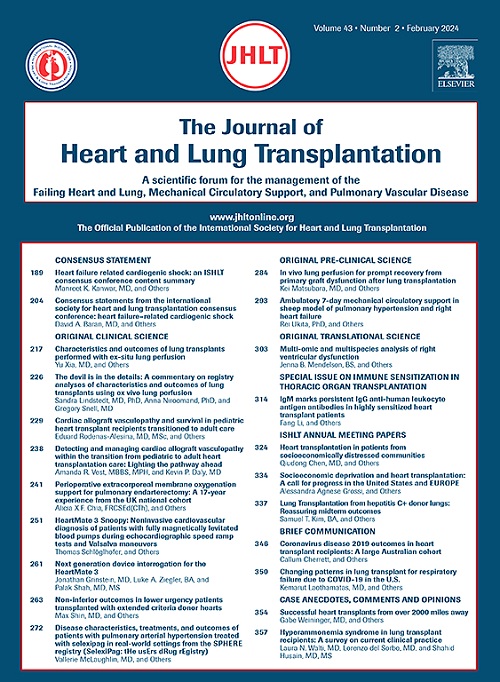Long-term follow-up of the randomized, prospective Scandinavian heart transplant everolimus de novo study with early calcineurin inhibitors avoidance (SCHEDULE) trial
IF 6.4
1区 医学
Q1 CARDIAC & CARDIOVASCULAR SYSTEMS
引用次数: 0
Abstract
Background
Early substitution of calcineurin inhibitor (CNI) with mammalian target of rapamycin inhibitors has been shown to improve kidney function and reduce intimal hyperplasia in heart transplant (HTx) recipients but data on long-term outcome of such a regime are still sparse.
Methods
In the SCHEDULE trial, 115 de novo HTx recipients were randomized to (1) everolimus with reduced exposure of CNI followed by CNI withdrawal at week 7–11 post-transplant or (2) standard-exposure with CNI. Both groups received mycophenolate mofetil and corticosteroids. Herein we report on the 10–12-year long-term follow-up of the study.
Results
A total of 78 patients attended the follow-up visit at a median time of 11 years post-transplant. In the everolimus intention to treat (ITT) group 87.5% (35/40 patients) still received everolimus and in the CNI ITT group 86.8% (33/38) still received CNI. Estimated glomerular filtration rate (eGFR) (least square mean (95% CI)) at the 10–12 years visit was 82.7 (74.2–91.1) ml/min/1.73 m2 and 61.0 (52.3–69.7) ml/min/1.73 m2 in the everolimus and CNI group, respectively (p < 0.001). Graft function measured by ejection fraction, ECG, NT-proBNP and drug safety were comparable between groups. During the study period there was a total of 28 deaths, but there was no difference in survival between the everolimus and the CNI group (aHR 0.61 (95% CI 0.29–1.30) p = 0.20). For the composite endpoint of death, re-transplantation, myocardial infarction, PCI, dialysis, kidney transplantation or cancer no between group differences were found (aHR 1.0 (95% CI 0.57–1.77) p = 0.99).
Conclusions
De novo HTx patients randomized to everolimus and low dose CNI followed by CNI free therapy sustained significantly better long-term kidney function than patients randomized to standard therapy. The graft function at 10–12 years was similar in both groups and there was no difference in survival.
斯堪的纳维亚心脏移植依维莫司从头开始研究与早期避免使用钙神经蛋白抑制剂(SCHEDULE)随机前瞻性试验的长期随访。
导言:有研究表明,早期用哺乳动物雷帕霉素靶点抑制剂替代钙神经蛋白抑制剂(CNI)可改善心脏移植(HTx)受者的肾功能并减少内膜增生,但有关这种疗法长期效果的数据仍然很少:在SCHEDULE试验中,115名心脏移植受者被随机分为两组:a)依维莫司组,减少CNI暴露,移植后第7-11周停用CNI;b)标准CNI暴露组。两组患者均接受霉酚酸酯和皮质类固醇治疗。我们在此报告该研究10-12年的长期随访结果:结果:共有 78 名患者参加了移植后 11 年的中位随访。在依维莫司意向治疗(ITT)组中,87.5%的患者(35/40)仍在接受依维莫司治疗;在氯化萘意向治疗(ITT)组中,86.8%的患者(33/38)仍在接受氯化萘意向治疗。依维莫司组和 CNI 组在 10-12 年访视时的估计肾小球滤过率(eGFR)(最小平方均值(95% CI))分别为 82.7 (74.2-91.1) ml/min/1.73m2 和 61.0 (52.3-69.7) ml/min/1.73m2 (p结论:随机接受依维莫司和小剂量氯化萘治疗后再接受无氯化萘治疗的新生肝移植患者的长期肾功能明显优于随机接受标准治疗的患者。两组患者10-12年后的移植物功能相似,存活率也没有差异。
本文章由计算机程序翻译,如有差异,请以英文原文为准。
求助全文
约1分钟内获得全文
求助全文
来源期刊
CiteScore
10.10
自引率
6.70%
发文量
1667
审稿时长
69 days
期刊介绍:
The Journal of Heart and Lung Transplantation, the official publication of the International Society for Heart and Lung Transplantation, brings readers essential scholarly and timely information in the field of cardio-pulmonary transplantation, mechanical and biological support of the failing heart, advanced lung disease (including pulmonary vascular disease) and cell replacement therapy. Importantly, the journal also serves as a medium of communication of pre-clinical sciences in all these rapidly expanding areas.

 求助内容:
求助内容: 应助结果提醒方式:
应助结果提醒方式:


